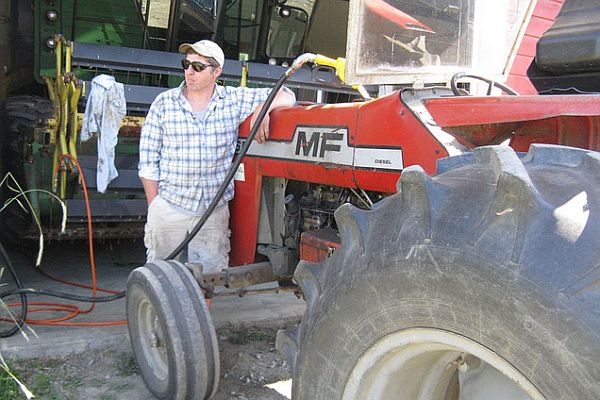
(Host) Some farmers in the Northeast are in the midst of an experiment in energy independence. They’re growing crops that produce the fuel to run their tractors and equipment.
As part of a collaboration with Northeast public radio stations, VPR’s Susan Keese reports.
(Keese) John Williamson pulls his tractor up to a shed on his farm in North Bennington. He reaches for a hose and starts filling his tank.
(Williamson) "That’s B-100 biodiesel. That was grown right here on our farm last year. That’s from sunflowers."
(Keese) For the past six years Williamson has run his farm machinery on 100% home-made biodiesel.
He started with used cooking oil from restaurants, but then began growing his own oil-rich crops, like sunflowers and canola seeds.
It’s been a process of trial and error, for Williamson and about 30 farmers in New England and New York, learning to grow new plants and finding the right equipment to harvest them. Williamson lost a lot of seeds at first.
(Williamson) "Like canola, for instance, is a very small seed you know, and then the littlest tiniest crack in your combine that would hold your corn or oats, it would flow right out like water."
(Keese) Those seeds not only yield fuel, but replace the grain Northeast farmers usually import from the Midwest.
(Williamson) "A lot of folks don’t realize these oil crops are grain. Once you squeeze the oil out you have that grain, that’s livestock food."
(Keese) Williams’ efforts drew the interest of the University of Vermont, which helped him find the funds for a new processing shed that handles oil crops from several farms.
Today he’s pressing sunflower seeds from a neighbor’s farm.
The press squeezes yellow oil from the seeds. The remaining seed meal is pushed through a nozzle in a continuous fat rope that breaks off into pellets that are used to feed livestock.
Two-hundred miles north, Roger Rainville dips into a sack of pellets from his oil seed mill.
More than making fuel, Rainville was interested in feed when he started growing oil crops.
(Rainville) "We wanted the canola or sunflower meal as a feed source, cause it’s real high protein, and our protein and our concentrates that we feed cattle are our most expensive ingredient. So the oil was going to be a byproduct."
(Keese) Now he runs five tractors on the biodiesel he makes.
(Rainville) "We have not ordered one ounce of fuel from the dealer since we started making biodiesel. And we’re doing this at a cost of $1.70 a gallon."
(Keese) Conventional diesel has run from $2 to nearly $5 a gallon at times over the past couple of years.
John Williamson says it costs $3 or $4 to make a gallon of fuel on his farm.
(Darby) "The pioneers don’t always end up in the front because they’ve had to take the heavy hits for everyone else."
(Keese) UVM agronomist Heather Darby is working to solve some of the challenges the fuel farmers face. She says birds, and other predators that eat the seeds have raised production costs on some farms.
(Darby) "The better we can do at growing the crops, figuring out the wildlife issues, figuring out the disease and the insect issues, the better the economics are going to look on this."
(Keese) State grants and technical support have been key in getting these bio-fuel projects started.
In western Massachusetts, members of a five-farm biodiesel collaborative hope they can grow and manufacture fuel for $2.50 a gallon, or less.
The Hilltown Biodiesel Project has built a portable processing unit.
Today it’s in Adams, Massachusetts, where Gary Alibozek is getting his first try at processing the seeds he grew last summer.
Alibozek hopes the end product will lower the cost of running his farm.
(Gary) "Over the last 10 years we averaged between ten and $18,000 a year in fuel costs, fuel and grain. And we view this as about a ten thousand dollar a year raise for our family."
(Keese) At a time when many family farms are sinking, he hopes to lead the way to one alternative that could help some survive.
For VPR News, I’m Susan Keese.
(Host) Northeast environmental reporting is made possible, in part, by a grant from United Technologies. The coverage is part of NPR’s local news initiative.